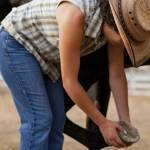The Two Phases of Laminitis

James Orsini, DVM, director of the Laminitis Institute, New Bolton Center, University of Pennsylvania, recognized two distinct phases of laminitis at a recent Central Kentucky presentation called “Is Laminitis Preventable? New Technologies to Manage the At-Risk Horse.” The two phases of the disease are developmental and acute.
The developmental phase occurs during the first 20-60 hours after exposure to the causative agent or inciting event, be it overconsumption of carbohydrates, retained placenta, colic, metabolic derangements (Cushing’s disease or equine metabolic syndrome), trauma, excessive weight bearing, ingestion of toxin, or medication intolerance (certain steroids).
The developmental phase ends and the acute phase begins at the first sign of lameness. The acute phase can last 24 to 72 hours. Aside from lameness, other clinical signs include a bounding digital pulse, heat in the hooves, a camped-out stance, and sensitivity to hoof testers. From a physiology perspective, once the horse segues from the developmental phase to the acute phase, some degree of damage to lamellar tissues is inevitable.
The acute phase can be further separated into a subacute or chronic phase based on the extent of lamellar damage. The subacute phase is characterized by minimal injury to the lamellar tissue, while the chronic phase is typified by more pronounced damage, including separation of the lamellar tissues that might eventually cause displacement of the coffin bone.
Any movement of the coffin bone from its normal, well-anchored position within the hoof capsule represents a serious problem. The extent of the bone’s repositioning determines its descriptor. When only a slight change of coffin bone position is shown on radiographic survey, it is called rotation. When there is a significant downward shift of the coffin bone toward the sole, it is called sinking. Prognosis for sinkers, as horses with a sinking coffin bone are sometimes called, is grave.
Veterinarians assess these factors when grading the severity of a laminitic horse in the acute phase:
- Stance
- Body condition score
- Degree of mobility
- Evidence of trauma
- Rate and quality of digital pulses
- Severity of pain
- Treading, shifting weight
- Ability to pick up feet
- Irregular growth of hoof wall (founder rings).
Laminitic horses that are identified in the first 24 hours of the developmental phase, before they show any clinical signs, have a favorable prognosis if cryotherapy is initiated immediately.
Understanding the phases of laminitis as well as the clinical signs associated with the disease will give horse owners a head-start in warding off this potentially perilous health threat.








